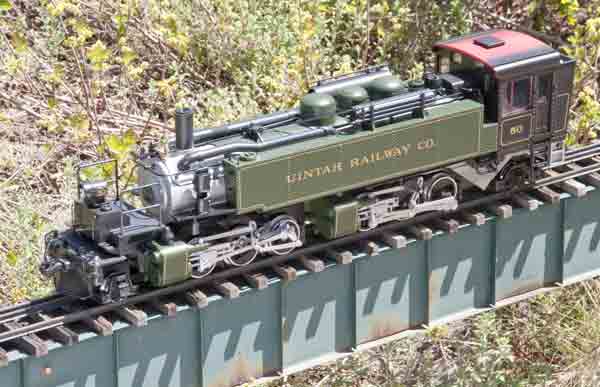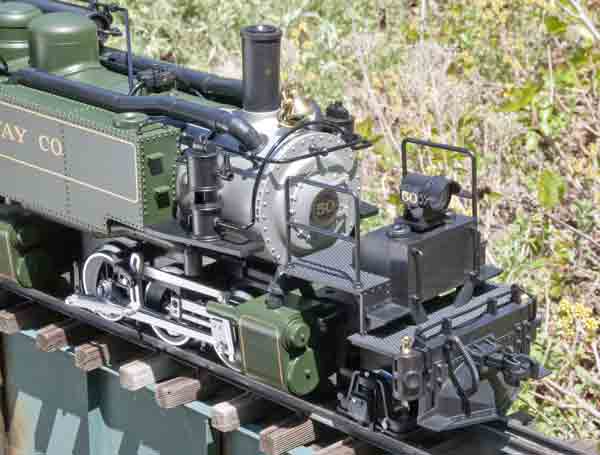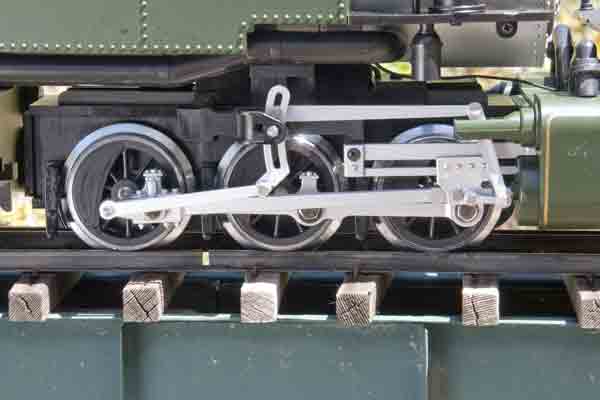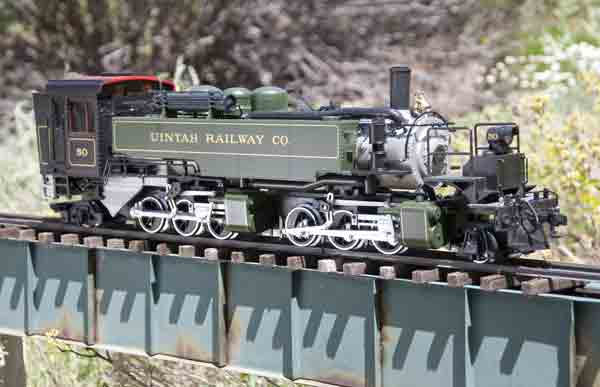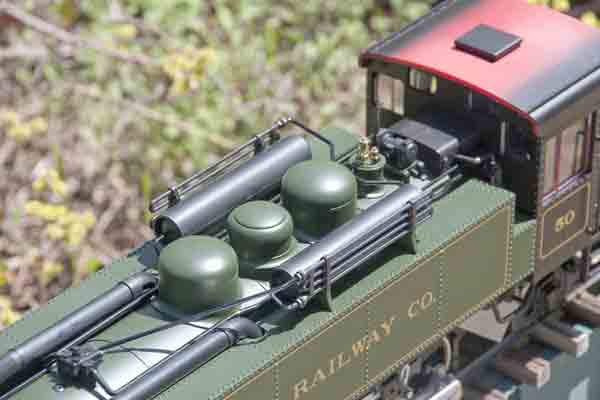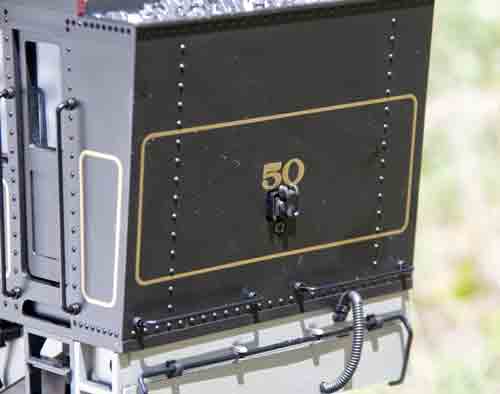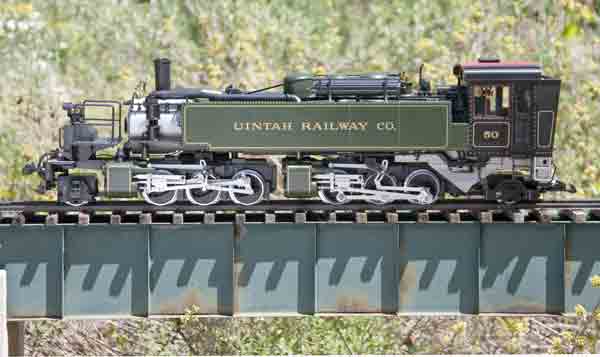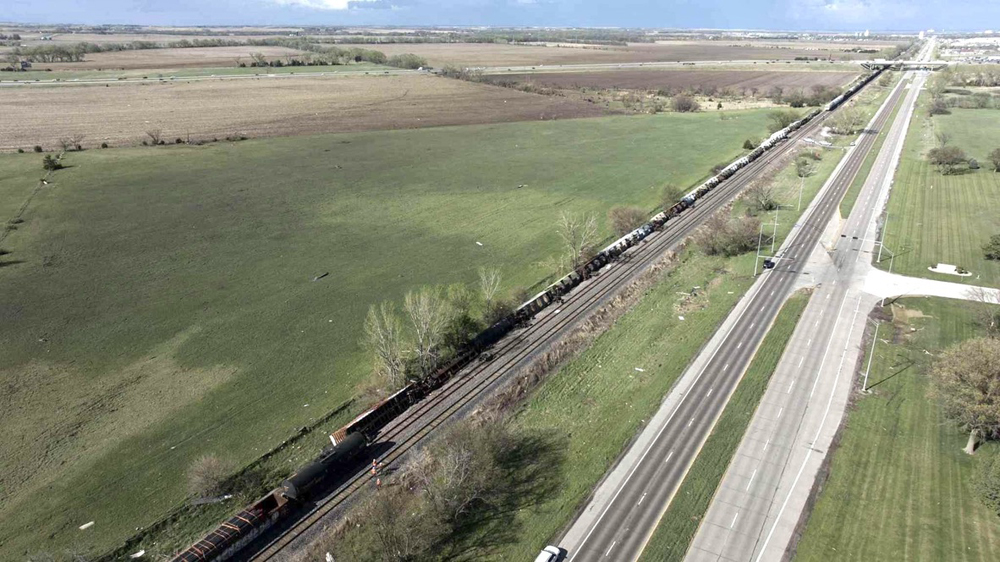LGB of Germany
Distributed in the US by:
Wm. K. Walthers Inc.
5601 W. Florist Ave.
Milwaukee WI 53218
Price: $919.98
Website: www.marklin.com
Mostly plastic model of Uintah Nº 50 articulated locomotive (#426-23881); two swiveling power trucks under boiler; two motors; six powered axles; 12 current pickup points; flickering firebox light; smoke unit; headlight; multi-purpose socket; hook-and-loop couplers; can be fitted with LGB’s MTS digital decoder; made in China. Dimensions: Length, 23″; width, 4 3/8″; height over stack, 6 ¾”. Weight, 8 pounds. Tractive effort: 1 lb. 11 oz., or enough for around 22 average freight cars on straight, level track
Pros: Attractive locomotive; reasonably good fidelity to prototype; excellent paint and graphics; usual LGB high standard of production and quality; smooth, quiet operation; upgradable to LGB’s digital control; reasonably high level of detail
Cons: Rudimentary instruction booklet; shiny wheel rims with over-deep flanges; no scale
specified
The model under review here is a reissue of LGB’s 2-6-6-2T, originally produced in the 1990s. The reissue has green tanks and cylinders whereas the original was all black. No scale is mentioned but, based on prototype dimensions, the engine appears to be close to 1:22.5, though small in some dimensions.
Visually, the model compares favorably to photos of the prototype, with all important details in place.
This locomotive is constructed primarily of different types of plastic. Some of the details—piping, handrails, etc.—are metal. Others that might be prone to breakage are made of soft, flexible plastic. The detail level is high and all are nicely produced. The cab interior is also detailed, though this must be viewed through the glazed cab windows. Cab doors are spring loaded and can be opened. Indeed, the only access to the mode switch on the backhead is through the cab doors. This switch supplies power to motors, light, and smoke unit. An engineer figure is provided separately, with a sticky pad with which to stick him to the floor of the cab.
A rudimentary instruction book is provided. I would like to have seen this be more complete. For instance, it says that LGB’s MTS digital-control system can be installed but gives no hint on how this might be accomplished or how to take the engine apart. Also, I noticed a speaker grill (no speaker) in the bottom of the firebox, suggesting that the engine is sound-system compatible but, again, no mention in the instructions. All you get are the most elementary operating and maintenance directions, along with all of the usual dire warnings about electricity.
At eight pounds, the engine is a chunk. It has two motors—one in each power truck—and 12 electrical pickup points. Only a single driver is fitted with a traction tire. Unprototypically, both of the power units swivel to get the engine around tight curves. The front unit is pivoted between the second and third axle while the rear unit actually swings from a point beneath the rear of the cab. The prototype would have had a rear unit that was rigid, integral with the frame, while the front unit would have been hinged at its rear. The model’s leading and trailing trucks are unsprung but are weighted, so they should track well. Wheels have LGB’s typical shiny tires with unnecessarily deep flanges. These are a bit of an eyesore but could be toned down by the judicious application of paint.
As supplied, the engine has a working headlight, flickering firebox light (difficult to see), and smoke unit, along with a small, initial supply of smoke fluid. A hook-and-loop coupler is attached to the trailing truck and a dummy knuckle coupler is attached to the pilot. There is no provision for body-mounting couplers, should you wish to do that.
On the back of the coal bunker is a “multi-purpose socket.” If you are run–ning on track power, this becomes an outlet into which you can insert a plug for passenger-car lighting. It can also be used to backfeed power to the engine from a battery in a trailing car.
I tested the locomotive with an LGB Jumbo 24V, 10-amp power pack. Performance of the engine is everything we have come to expect from LGB. It’s smooth, quiet, and powerful. With its single traction tire, the engine has enough tractive effort to haul around 22 average freight cars on straight, level track. Top speed, at 24V, is a tad high, but not too much. At the low end, the engine will just creep along. At 24V, full slip, the engine only draws about 1 amp of power.
Although this is a model of an unusual prototype and may not be for everyone, it is nevertheless a fine piece of engineering in the time-honored LGB tradition. It is every bit as good as the company’s earlier release of this engine.
I should mention that, along with the locomotive, I was sent LGB’s 2011 catalog and 2012 new-products supplement. Last-year’s catalog was 164 pages and this-year’s supplement another 68. While most of the trains were European, there were American offerings as well. It appears from this that LGB is well on the way toward re-establishing itself as a strong player in America’s large-scale-train market.





